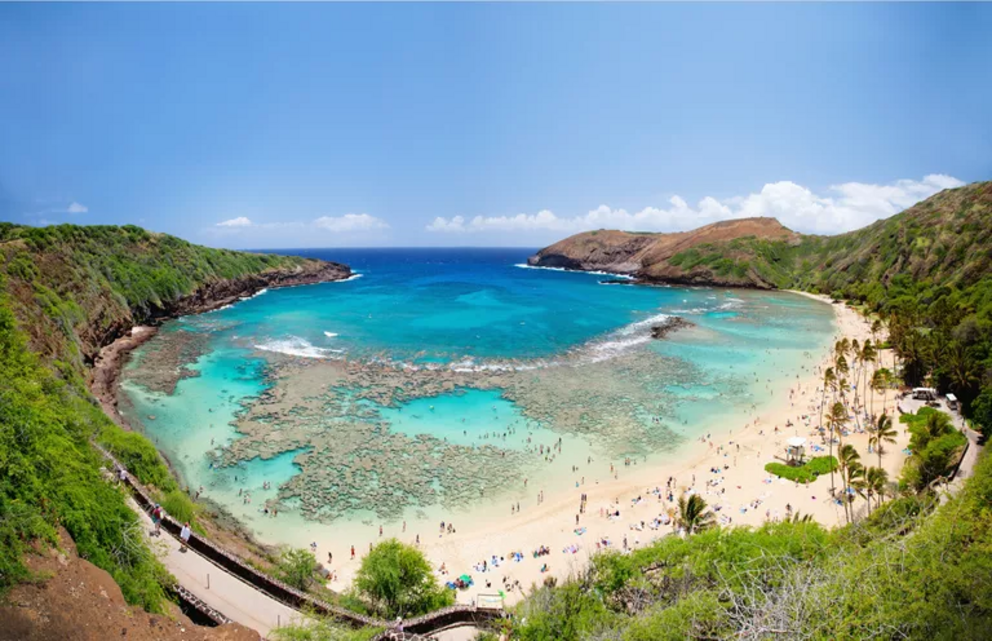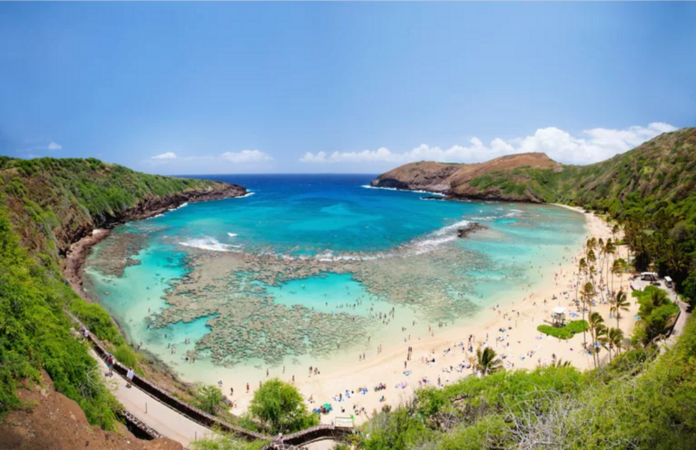
Sunscreen pollution threatens Hawaii’s Hanauma Bay
Hanauma Bay.
Research shows the harmful chemical oxybenzone transferring from swimmers to fragile coral reefs.
Sunscreen is supposed to protect you from harm. At least one type of sunscreen, however—oxybenzone sunscreen—might also be causing you harm.12
According to concerned consumers at the Environmental Working Group, a nonprofit organization that rates sunscreen safety based on published scientific literature, oxybenzone is readily absorbed by the body, lingers for weeks on the skin and in the blood, and may disrupt hormone production.2
It’s not just humans that are imperiled by oxybenzone, however; it’s also the environment that suffers significantly as a result of contamination from sunscreen that contains this chemical. This was confirmed in a new study published this month in the scientific journal “Chemosphere.”1
Conducted by a large team of international scientists—including researchers at the Spanish Research Council in Spain, the Centre National de La Recherche Scientifique in France, and the National Oceanic & Atmospheric Administration (NOAA) in the United States—the study focuses on Hawaii’s Hanauma Bay, a popular swimming destination in Honolulu that has attracted up to 3.5 million visitors per year since the 1980s. Most of these visitors use over-the-counter sunscreen, according to the study’s authors, who collected water and sand samples from Hanauma Bay in 2017 in order to measure the concentrations of oxybenzone in the environment.1
Based on their measurements, scientists then conducted analyses to determine the danger that oxybenzone poses to marine life in Hanauma Bay’s fragile coral reef system. Their research yielded three major findings:
- First, researchers concluded that swimmers are sources of sunscreen pollution, and that levels of oxybenzone can reach concentrations that threaten the survival of coral reef and seagrass ecosystems. Particularly vulnerable are sea turtles and monk seals, which are frequent visitors to Hanauma Bay.1
- Second, researchers determined from sand samples that beach showers are another source of sunscreen pollution. Currently, the showers discharge directly into the beach and bay. Under the U.S. Clean Water Act, however, discharge should be collected with the municipal sewage system and pumped out of the bay into a sewage treatment system.1
- Finally, researchers surmised that the bay’s geology—it features volcanic walls that protect and enclose it—are not only a major reason for its popularity with swimmers, but also a significant factor in its retention of sunscreen pollution. Oceanographic models show that sunscreen pollution from a single day’s contamination can linger in the bay for more than two days. This means sunscreen pollution can build up for each successive day that the bay is open to visitors.1
The study’s conclusions are shocking but not surprising, as scientists and environmentalists have long known about the negative impacts of sunscreen pollution on Hanauma Bay. In fact, Hawaii in May 2018 became the first U.S. state to ban the sale of over-the-counter sunscreens containing oxybenzone. The law, which was designed to protect marine ecosystems like the one in Hanauma Bay, went into effect on Jan. 1, 2021.
“Studies have documented the negative impact of these chemicals on corals and other marine life,” Hawaii Governor David Ige said upon signing the law. “Our natural environment is fragile, and our own interaction with the Earth can have lasting impacts. This new law is just one step toward protecting the health and resiliency of Hawaii’s coral reefs.”
The scientists studying Hanauma Bay plan to use the data they collected in 2017 as a baseline for future research. Going forward, for example, they plan to contrast their original samples with samples collected in 2020 and 2021, during which time visitation to Hanauma Bay was dramatically curtailed—first because of COVID-19, which closed the bay entirely from March 2020 to December 2020, and subsequently because of local restrictions.
“In 2021, the City of Honolulu has limited the number of visitors to no more than 1,000 persons per open day,” the researchers write in their study. “This management policy may have a positive impact in reducing contaminant loads in the bay, and a follow-up contaminant survey may provide data not only to assess this possibility, but to also determine a more effective carrying capacity program for Hanauma Bay.”
Fact checked by Haley Mast

